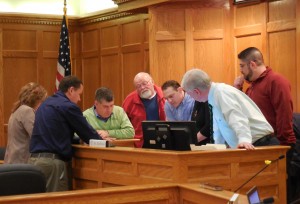WESTFIELD—In recent months the city’s many elected boards, especially planning and city council, have seen an influx of public participation and frustration.
While this public participation is good for democracy, it is important to be aware of what discourse is expected with these boards and what kinds of meetings there actually are in the city. With the increased knowledge of the different types and the way they are expected to be conducted, it can help streamline the meetings while also improve the addressing of concerns that citizens have.
What is a public meeting?
“A public meeting is any time a body meets,” Sue Phillips, Westfield city solicitor, said.
So, any time the planning board, city council, airport commission, zoning board of appeals or any of the other boards, commissions or councils meet, it’s considered a public meeting, according to Phillips, who cited Massachusetts General Law (MGL), Ch. 30A-20.
In addition, these meetings, according to the state law, must be held in public and the city must give an advance notice of at least 48 hours, excluding weekends and holidays. This doesn’t apply to emergency meetings though, such as the one that was scheduled during the summer when Westfield had to declare a water ban. In that instance, notice is set to be as soon as possible.
Also, meetings may go into executive session, which are closed to the public, according to MGL 30A-21. More often than not, you will see these on posted notices of public meetings, and they are meant to allow for discussion of more sensitive matters, such as contract negotiations, well-being or ability of elected members, pending litigation or potential business dealings that could be affected by public discussion.
This doesn’t mean that these meetings are forever confidential, however. According to Phillips, all executive session minutes are kept and are accessible to the public, after it is deemed that public knowledge will not hinder the decision. These minutes can then be requested through the law department of the city, and select ones are also available on the city’s website.
Additionally, all meetings are meant to have public interaction. Usually, public meetings have portions of it set aside for the public to ask questions or address the board or council on topics not on the schedule of to be talked about. Also, most topics that are on the docket will have a portion dedicated to questions from the public, so people can wait until then to address concerns, too.
Public hearing versus public meeting

The Westfield Planning Board reviews schematics before a public hearing in March 2016. (Photo by Amy Porter)
Of course, public meetings and executive sessions aren’t the only kinds of meetings in municipal government.
Another one, which are more frequent among the planning board and city council, are public hearings.
“Public hearings should have more formality,” Phillips said.
These meetings take place when a deliberation over something is going to occur, especially something that will have more complicated measures to it.
Questions from the public may also be asked during this portion, but only during public participation and the questions should be related to the topic or discussion. The way that these meetings proceed though, is not dictated by state law. Instead, according to Phillips, municipalities determine how the public portion may proceed.
One standard is constant with these meetings, however—facts.
“A public hearing is a chance for the board to hear evidence,” Phillips said.
“All information the board will hear has to come through those meetings,” she said.
In addition, Phillips said that those who are deliberating are not allowed to discuss their views or findings with each other while out of public hearing if the topic of discussion is related to a pending hearing. Also, members are not allowed to do independent research on a topic without sharing it with everyone, so all the same facts are being deliberated.
Of course, this can lead to a much longer process than a simple roll call vote, since more complicated matters often have continuations, or extensions on the public hearings to further analyze the facts presented. This was the case with the Roots Athletic Complex on Root Road as an example, which saw several continuations over many months, and is now being brought to court by Roots.
Voting in meetings
Finally, when it comes to a board’s decision, they always come down to votes. These votes may be a roll call vote, where each member announces their decision separately and is reserved for more controversial topics, or an acclamation vote, which is where the voters say “aye” or “nay” to a question presented.
Regardless of the type of vote, there is one constant that remains when it comes to voting—it must be done in front of the public.
“Votes must occur in public meeting or session,” Phillips said. “They can do a roll call in executive session but must vote again in public session.”


